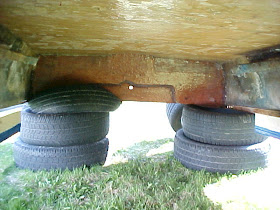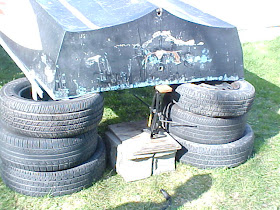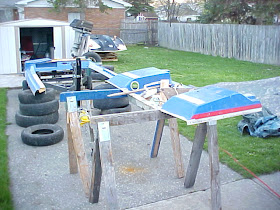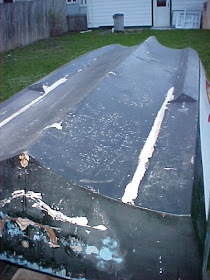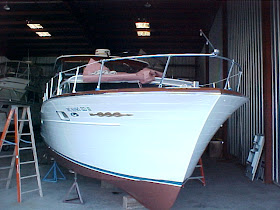
There is an old saying that says there are only two happy days one has owning a boat. The first day is when it is bought and the second when he sells it.
In mid April was the only time I began to think that maybe I took on more than what I could handle.
Stripping off the latex paint revealed serious delamination and cracks in the gelcoat. Blistering is severe nearer to the stern.
Gelcoat is the outer skin of a fiberglass boat. Fiberglass isn't waterproof and gelcoat makes it so. However, if both don't laminate together right or the gelcoat is cracked problems will happen.

Gelcoat scratches, blistering and cracks are everywhere.

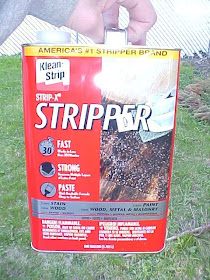 Stripper from Lowe's was used to get the paint off. The 15 minutes recommended is too much. It lifted the paint off but also softened the gelcoat in test spots. One minute from brushing it on was all that was needed.
Stripper from Lowe's was used to get the paint off. The 15 minutes recommended is too much. It lifted the paint off but also softened the gelcoat in test spots. One minute from brushing it on was all that was needed.On and off for a couple of weeks I worked at stripping paint, finding more and more damage.
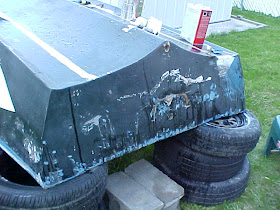


 The large flames were carefully peeled off with a scraper and heat gun. I calculate that the flames on the original Batboat made in 1966 were a little more than 6 inches height and these were over twice that.
The large flames were carefully peeled off with a scraper and heat gun. I calculate that the flames on the original Batboat made in 1966 were a little more than 6 inches height and these were over twice that.

 The original white and "Glacier Blue" of the V-145 Glastron runabout finally shows through.
The original white and "Glacier Blue" of the V-145 Glastron runabout finally shows through.
All of the really bad blistering damage to the gelcoat is consentrated in one area (outlined in yellow). Looking closer, this is mostly where white gelcoat is on top of a blue layer of gelcoat and where blue is on top of white and blue.
Advice from boat forums, watching instructional youtube videos and reading over repair product information helped me to decide to keep working and finish the Batboat.
It isn't as bad as it first seemed but this will add a week or two to the project and unexpected $$$.







